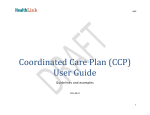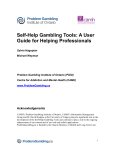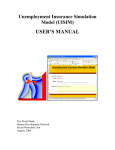Download Outcomes framework user guide - Department of Human Services
Transcript
Outcomes Framework User Guide Version 1.0 January 2015 Department of Health & Human Services The Outcomes Framework Contents Introduction .................................................................................................................................................1 Measuring outcomes: an overview of the outcomes framework ..........................................................2 Housing .......................................................................................................................................................3 Work and meaningful use of time .............................................................................................................5 Learning and development ........................................................................................................................6 Cultural and social wellbeing ..................................................................................................................10 Health .........................................................................................................................................................13 Safety .........................................................................................................................................................15 Behaviours and risk .................................................................................................................................18 Outcomes Framework User Guide Introduction The purpose of this guide is to provide detailed information regarding the process of tracking outcomes measures for Services Connect clients. Traditionally human services have measured inputs such as the amount of funding provided and outputs such as the number of services delivered. Services Connect is shifting the focus to measure outcomes. An outcomes framework provides one approach to fully understand whether the services being funded and delivered are having a real and lasting impact for vulnerable Victorians. Measuring outcomes tells us if we have achieved what we want to achieve for clients. The outcomes framework being tested through Services Connect has seven outcome areas. Each outcome area is underpinned by ‘indicators’ and ‘measures’ that will allow us to assess if change has occurred for clients following interventions received through Services Connect. Some outcome measures are more long term and may not change or are unlikely to change during the course of Services Connect intervention. Below is an example of the process used to determine outcomes for clients. Example 1: Client presenting with a physical disability and facing mobility and access issues. Previously we may have measured and recorded that this client was provided with a wheelchair and adaptations were made to their home. The wheelchair and housing adaptations are the outputs (interventions). The information does not tell us what impact these interventions have had on the client’s life. Using an outcomes framework we will measure actual change, such as whether the client’s house is now more suitable and meets their needs. We will also measure changes to the client’s physical and mental health and social wellbeing as a result of being provided with a wheelchair and more suitable housing. Inputs Activities Outputs Outcomes Outcomes (what is available) (what can you offer) (what can you achieve with what you can offer) What resources are available to help achieve change for this person? What activities/ services will help achieve maximum impact? What will you offer your client that will help achieve maximum impact? (short term) (what are the expected short term changes) How will you know the interventions are working? (long term) (what are the expected long term changes) What long term changes would you expect/like to see that will indicate that the interventions and support have worked? How much support/service provision is required to achieve real change? Key worker Client and family members Funding packages. Funding available for mobility aids Home maintenance program Community referral program. Provision of wheel chair Housing adaptations including installation of an access ramp Arrange for community transport scheme to transport client to and from the local neighbourhood house to attend weekly social programs. What short term changes would you expect/like to see for this person that will indicate that the interventions and support are working and the client is progressing towards their goals? Client reports that housing is more suitable and meets their needs Client reports an increased ability to prepare and cook meals alone at home For the first time, client attends a weekly cooking program and becomes a member of the community garden committee. Client is supported to live independently Client is physically and mentally well Client is engaged in regular meaningful activity. Page 1 Outcomes Framework User Guide An overview of the outcomes framework Outcome Area Outcome Indicators What we are trying to capture Housing Suitable housing Suitability and appropriateness of housing conditions including overcrowding, living conditions and location. Stable housing Stability and affordability of current living arrangements including security of housing tenure. Work and meaningful use Engagement in the labour market Extent of engagement in paid employment. of time Engagement in Outside of paid employment, extent of engagement in meaningful activity that may meaningful activity contribute to a range of economic, social, health and wellbeing outcomes. Early childhood development Early childhood development and overall wellbeing including indications of future health, development and wellbeing. School achievement School achievement and participation including school attendance, learning difficulties Learning and development and educational stability. Post compulsory Extent of engagement in learning and achievement outside of the formal primary or learning secondary school environment. Independent living Ability to function and live independently and whether additional support is required. skills Cultural and Family and social wellbeing relationships Health Safety Extent of quality relationships including family, cultural and social connections. Sense of place and Connectedness and belonging to cultural and spiritual communities including belonging engagement in relevant cultural events and activities. Social involvement Extent of involvement in social and recreational activities. Mental health Mental health and wellbeing including factors that may affect state of mental health. Physical health Physical health and wellbeing including factors that may affect state of physical health. Abuse and neglect Existence and extent of abuse and neglect including child and elder abuse, physical, sexual and financial abuse and neglect. Family violence Existence and extent of family violence. Injury Extent of injury including self harm and physical abuse. Safe environment Existence of abuse, bullying, violence, coercion or exploitation inside and outside the home. Behaviours Alcohol and other Alcohol and drug consumption including impact and risks of alcohol and drug use. drug use Sexual risk Sexual exploitation, sexual assault and abuse including autonomy of decision making and consent. Financial stability Level of financial stability and extent of financial security. Gambling Extent and impact of gambling. Offending Levels and patterns of offending behaviours. Page 2 Outcomes Framework User Guide Housing This outcome area focuses on people and families having suitable and stable housing. There are two indicators for this outcome area: 1. Suitable housing 2. Stable housing Suitable housing The purpose of this indicator is to determine the suitability, appropriateness and adequacy of current housing arrangements, and the extent to which household members have the space and control of living space and facilities. Background information There are a range of factors that determine housing suitability, these include: the physical state of the housing arrangements; whether there are enough bedrooms for children and adults living in the house; whether living arrangements are age and gender appropriate; whether the kitchen allows for the preparation of food; length of housing tenure; and the extent to which the cost associated with maintaining the upkeep and expenses of the housing arrangements are appropriate, when matched with household income. Other considerations include; whether household members can access a private bathroom; whether children have space and a suitable environment to do homework; and proximity to public transport to access local services. Outcome indicator Suitable housing Questions for capture Answers Do you currently have enough bedrooms for your household members? Yes No Not applicable for this client Never Sometimes Most of the time Almost always Not applicable for this client Yes No Not applicable for this client Yes No Not applicable for this client Yes No Not applicable for this client If you live in a rooming house, aged care facility or other congregate living arrangement other than a family home, do you have access to a private bathroom? If there is a person in the house who has additional needs due to health or disability, does your housing have all the required facilities? Is your housing well located for your needs? Is your housing more expensive than you can reasonably afford? Page 3 Outcomes Framework User Guide Stable housing The purpose of this indicator is to determine stability and affordability of current living arrangements including security of housing tenure. Background information Stability of housing has an impact on issues such as; homelessness or likelihood of homelessness; financial difficulties; gambling problems; physical and mental health implications such as depression; poor nutrition; substance misuse; and family breakdowns. Another consideration is the extent to which people are accessing help and support such as rental assistance schemes, as this will have a direct impact on security of housing tenure. Outcome indicator Stable housing Questions for capture Answers Are you currently homeless? Yes No Not applicable for this client If you are currently homeless, which of the following best describes your situation? (If more than one is applicable, select the most recent or relevant). Do you have a housing/lease agreement of 12 months or more? Can you stay in your current housing for as long as you like? How many times have you moved in the last 12 months? If you have moved in the last 12 months, in which month was your last move? How many weeks of rent do you owe? If you owe one or more weeks of rent, what is your weekly rent? Staying with relatives Staying at a friend's house Staying in a caravan Staying in a boarding/rooming house or hostel Staying in a night/homeless shelter Yes No Not applicable for this client Yes No Unsure Not applicable for this client 0 1 2 3 4 5 January February March April May June July 0 1 2 3 4 5 $1‐$74 $75‐$99 $100‐$124 $125‐$149 $150‐$174 $175‐$199 Staying at a refuge Squatting in an abandoned building Sleeping rough Living in a severely overcrowded dwelling Not applicable for this client 6 7 8 9 10+ Not applicable for this client August September October November December Not applicable for this client 6 7 8 9 10+ Not applicable for this client $200‐$224 $225‐$249 $250‐$274 $275‐$299 $300 and over Not applicable for this client Page 4 Outcomes Framework User Guide Work and meaningful use of time This outcome area focuses on people and families being meaningfully engaged. There are two indicators for this outcome area: 1. Engagement in the labour market 2. Engagement in meaningful activity Engagement in labour market The purpose of this indicator is to determine the extent of engagement in the labour market. Background information Involvement in the labour market will have a direct impact on quality of life. Security of employment can be an issue. Other considerations include whether people experience barriers to employment and whether they are accessing all available employment pathways. Very often those not participating in employment or other meaningful activity such as education or training, are more likely to experience social and economic disadvantages, poorer physical and mental health or social exclusion (See the learning and development indicator on page 6). Outcome indicator Questions for capture Answers Engagement in the labour market What is your employment status? Employed full time Employed part time Employed on a casual basis Employed on a contract basis Not employed and looking for work Yes No Not applicable for this client Would you prefer to work more than you currently do? Not employed and not looking for work Not in labour force Not applicable for this client Engagement in meaningful activity The purpose of this indicator is to determine the extent of engagement in meaningful activity (excluding paid employment). This indicator is closely related to the labour market measure described above and should be considered in conjunction with it. Background information The benefits that flow from employment may also be gained from engagement in other forms of activity such as participation in full time education and training or volunteering. It is important that the extent of participation in non-work activity is regular. Engagement in meaningful activity can contribute to a range of economic, social, health and wellbeing outcomes. Outcome indicator Questions for capture Answers Engagement in meaningful activity Which of the following activities do you regularly engage in? (select all that apply) Education/training Caring (full time/part time) Volunteering Extra-curricular programs/activities Work experience Not applicable for this client Page 5 Outcomes Framework User Guide Learning and development This outcome area focuses on the learning and development of people and families. There are four indicators for this outcome area: 1. 2. 3. 4. Early childhood development School achievement Post compulsory learning Independent living skills Early childhood development The purpose of this indicator is to measure early childhood development among children. Indicators of early childhood development are predictors of long term life outcomes in terms of both health and wellbeing. Background information Access to high quality early childhood education and care, the development of language, and early identification of emotional or behavioural issues are well known indicators of early childhood development and future health, development and overall wellbeing. Considerations include: whether the extent of involvement in early childhood education is regular and meaningful; and whether children are actively involved when people read to them. Outcome indicator Questions for capture Answers Early childhood development How many days per week are the children in the household read to? 0 1 2 3 4 5 6 7 Not applicable for this client Yes No Not applicable for this client Does the young person attend a government approved early childhood education and care service? Page 6 Outcomes Framework User Guide School achievement The purpose of this indicator is to assess school achievement of children and young people. Education achievement is an indicator of current wellbeing but is also an important factor for future life chances. Background information It is not enough to consider and measure attendance and participation in school – what is important is consideration and measurement of actual achievement as this is the outcome that helps predict employment outcomes later in life. The ability to read, write and perform mathematics is essential in day to day life and for educational opportunities and employment. If children are not actively involved and achieving in school, some of the reasons for this may include: access barriers, learning difficulties and or other issues such as bullying. Outcome indicator School achievement Questions for capture Is the young person currently enrolled in school, including Vocational Education and Training (VET)? If the young person is currently enrolled in school (including VET), how many days per week does he/she attend? During the previous four weeks of school, how many days has the young person been absent for any reason? Has the young person had difficulty progressing from one school year to another in the last 12 months? How many reports have been unsatisfactory over the last 12 months? Has the young person's school contacted you with concerns about their performance or behaviour in the last 12 months? Has the young person been excluded from school in the last 12 months? If the young person has been excluded from school in the last 12 months, how many times has this occurred? If the young person has been excluded from school in the last 12 months, in which month did this last occur? How many schools has the young person attended in the last 12 months? If the young person has attended more than one school in the last 12 months, in which month was the last move? Answers Yes No Less than 2 days At least 2 days At least 3 days At least 4 days 0 1 2 3 Yes No 0 1 2 Yes No Not applicable for this client Full time Not at all Not applicable for this client 4 5 5+ Not applicable for this client Not applicable for this client 3 4 Not applicable for this client Not applicable for this client Not applicable for this client 9 10+ Not applicable for this client Yes No 1 2 3 4 January February March April May 0 1 2 3 5 6 7 8 June July August September October 4 5 6 7 January February March April May June July August September October November December Not applicable for this client 8 9 10+ Not applicable for this client November December Not applicable for this client Page 7 Outcomes Framework User Guide Post compulsory learning The purpose of this indicator is to assess post compulsory learning. Higher educational attainment and training increase employability and reduce poverty in the context of a knowledge based economy. Background information Post compulsory learning applies to both formal post-compulsory education (such as tertiary education) and non-school qualifications (such as apprenticeships) – both these learning opportunities give people additional skills and qualifications beneficial to their life chances. Providing supports that contribute to people achieving more and better skills and competencies allows them greater opportunities for future success. Outcome indicator Questions for capture Answers Post compulsory learning Have you completed a subject or module in any of the following: TAFE/vocational education institution, adult community education centre, business college, professional association, industry association, university or other tertiary institution? If you have completed at least one subject or module in any of the above institutions, how many subjects or modules have you completed? Yes No Not applicable for this client 1 2 3 4 5 6 7 8 9 10 Not applicable Independent living skills The purpose of this indicator is to measure the extent to which people’s independent living skills meet their needs. Independent living skills are important as they provide people with foundation skills required to manage their lives and increase their participation in society. Background information Independent living skills are essential for daily living and can impact on quality of life. It is important to determine the extent to which a person can perform all necessary tasks required for daily living. Considerations include: whether they need help and support to develop independent living skills in areas such as social skills, family and other relationship skills, budgeting and managing money, catching public transport, personal care, cooking and housekeeping. Outcome indicator Independent living skills Questions for capture Answers Are you able to take care of and manage your house (e.g. wash clothes, clean)? Yes Learning to do Not learning to do Not applicable for this client Are you able to shop for food and prepare healthy meals? Yes Learning to do Not learning to do Not applicable for this client Are you able to make and keep appointments (e.g. doctor, hairdresser)? Yes Learning to do Not learning to do Not applicable for this client Page 8 Outcomes Framework User Guide Are you able to fill in forms (e.g. applications for housing, Medicare, bank account, Centrelink etc.) Yes Learning to do Not learning to do Not applicable for this client Are you able to read and understand information in letters, bills and contracts (e.g. telephone, gas, electricity)? Yes Learning to do Not learning to do Not applicable for this client Do you understand the set up and running costs of housing? Yes Learning to do Not learning to do Not applicable for this client Do you understand and know how to manage contracts and bills (e.g. mobile phone, credit cards? Yes Learning to do Not learning to do Not applicable for this client Do you understand the good and bad points about buying on credit? Yes Learning to do Not learning to do Not applicable for this client Are you able to set up and follow a budget? Yes Learning to do Not learning to do Not applicable for this client Do you have basic financial skills (e.g. counting change, using an ATM)? Yes Learning to do Not learning to do Not applicable for this client Can you advocate for yourself or access advocacy support? Yes Learning to do Not learning to do Not applicable for this client Page 9 Outcomes Framework User Guide Cultural and social wellbeing This outcome area focuses on people and families being culturally and socially connected. There are three indicators for this outcome area: 1. Family and relationships 2. Sense of place and belonging 3. Social involvement Family and relationships The purpose of this indicator is to measure the quality of relationships that people have with their family and friends. Close personal networks (e.g. family, friends, and neighbours) provide people with support for dealing with everyday life, taking on challenges, developing new skills and exploring new roles and experiences. Background information Family relationships are the most important social relationships in the lives of most people, especially children and young people, and have a direct influence on development of strong social skills, resilience, self-esteem and on social and emotional wellbeing. Friendships outside the family provide a sense of belonging and companionship for people. Unhealthy relationships, such as those involving conflict or social stress, are known to adversely affect the wellbeing of children, young people, families and communities. Outcome indicator Family and relationships Questions for capture Answers Do you have a strong relationship with someone you live with? Yes No Not applicable for this client Yes No Not applicable for this client Less than once 6 1 7 2 8 3 9 4 10+ 5 Not applicable for this client Yes No Not applicable for this client Less than once 6 1 7 2 8 3 9 4 10+ 5 Not applicable for this client Do you have regular contact with family or friends outside your home? If you have regular contact with family or friends outside your home, how many times per week on average does this contact occur? Do your parents/carers spend time 'just talking' to you? If your parents/carers spend time 'just talking' to you, how many times per week does this happen? Page 10 Outcomes Framework User Guide Sense of place and belonging The purpose of this indicator is to measure the sense of place and belonging that people experience. Feeling a part of the local community is an important enabler for developing a sense of belonging and permanency. Background information Connectedness and belonging is important for wellbeing. For Aboriginal people this indicator has particular significance, with connectedness to family, land, identity, and culture all identified as being central to the development of resilience and strong positive social networks and relationships. Developing positive and supportive relationships within culturally and linguistically diverse (CALD) communities is also an important affirmation of cultural identity and wellbeing. Outcome indicator Questions for capture Answers Sense of place and belonging In the last three months have you participated in any of the following: Local indigenous network, registered Aboriginal parties, National Aboriginal and Islander Day Observance Committee activities, Aboriginal youth forums or sport and recreation events, reconciliation events or services provided by Aboriginal Community Controlled Organisations? If you have participated in any of the above listed activities in the last three months, how many times has this happened? Yes No Not applicable for this client Do you have regular contact with other Aboriginal children/young people? If you have regular contact with other Aboriginal children/young people, how many times per week? Do you have regular contact with other children/young people from your community/culture of origin? If you have regular contact with other children/young people from your community/culture of origin, how many times per week? Do you attend events relevant to your culture or community? If you attend events relevant to your community or culture, how many times per month? 1 7 2 8 3 9 4 10+ 5 Not applicable 6 for this client Yes No Not applicable for this client 1 7 2 8 3 9 4 10+ 5 Not applicable 6 for this client Yes No Not applicable for this client 1 7 2 8 3 9 4 10+ 5 Not applicable 6 for this client Yes No Not applicable for this client 1 7 2 8 3 9 4 10+ 5 Not applicable 6 for this client Page 11 Outcomes Framework User Guide Social involvement The purpose of this indicator is to measure the extent to which people are socially involved in the community around them. Access to a fulfilling social life is important for everyone regardless of their circumstances and life stage. Background information Involvement in regular recreational and social activities helps improve quality of life, builds positive feelings and reduces isolation which is important in building resilience, needed to cope with day to day living. Having strong social networks not only provides emotional support that is helpful in difficult times but also expands opportunities for accessing employment and other material supports. Outcome indicator Social involvement Questions for capture Answers Do you participate in: social and recreational activities or social and community networking activities? Yes No Not applicable for this client Page 12 Outcomes Framework User Guide Health This outcome area focuses on the physical and mental health of people and families. There are two indicators suggested for this outcome area: 1. Mental health 2. Physical health Mental health The purpose of this indicator is to measure the mental health and wellbeing of people. The World Health Organisation (WHO) defines being mentally healthy as a state of wellbeing in which the individual realises his or her abilities, can cope with the normal stresses of life, can work productively and fruitfully, and is able to make a contribution to his or her community. Background information There is a range of factors that affect mental health. Mental health is an essential part of personal wellbeing and strongly influences family relationships, and the ability to contribute to and participate in society. Mental health also significantly influences life expectancy, employment status and financial position. Consequently mental illness is associated with enormous health, social and economic costs for individuals and for the community more broadly. Outcome indicator Questions for capture Answers Mental health Have you deliberately hurt yourself in the past six months? Yes No Prefer not to say Not applicable for this client Yes No Prefer not to say Not applicable for this client Enter score: Not applicable for this client Have you attempted to hurt yourself in the past six months? What is the Kessler 10 score? The Kessler 10 assesses levels of anxiety and depression to provide a measure of psychological distress What is the Strengths and Difficulties (SDQ) score? The Strengths and Difficulties questionnaire is a behavioural screening questionnaire for children and young people aged 3-16 years old. Enter score: Not applicable for this client Page 13 Outcomes Framework User Guide Physical health The purpose of this indicator is to measure the physical health and wellbeing of people. Physical health influences numerous aspects of people’s lives and provides a basis for life outcomes. Background information There are numerous factors (individual, family, social, economic, neighbourhood, environmental and political) that affect the achievement of good physical health. Outcome indicator Questions for capture Answers Physical Health Was child born with low birth weight? Yes No Not applicable for this client Yes No Not applicable for this client Yes No Not applicable for this client Vigorous Moderate Light None (sedentary) Not applicable for this client Up to 15 minutes per day Up to 30 minutes per day Up to 45 minutes per day Up to 60 minutes per day Over 60 minutes per day Not applicable for this client 5 1 6 2 7 3 Not applicable for 4 this client 0 2 or more 1 Not applicable for this client 1 5 2 6 3 7 4 Not applicable for this client 0 4 1 5 or more 2 Not applicable for 3 this client 1 5 2 6 3 7 4 Not applicable for this client Yes Not applicable for No this client At least daily At least weekly At least monthly Not applicable for this client Has child been to all scheduled maternal and child health appointments? Does child have up to date immunisations? What sort of physical activity do you regularly engage in? If you regularly engage in physical activity, how many minutes per day would this last? If you regularly engage in physical activity, how many days per week would you undertake this level of physical activity? How many serves of fruit do you consume per day? How many days per week would you consume this amount? How many serves of vegetables would you consume per day? How many days per week would you consume this amount? Do you miss meals because you have run out of food and cannot afford to buy more? If you miss meals because you have run out of food and cannot afford to buy more, how often does this happen? Page 14 Outcomes Framework User Guide Safety This outcome area focuses on the safety of people and families. There are four indicators for this outcome area: 1. 2. 3. 4. Abuse and neglect Family violence Injury Safe environment Abuse and neglect The purpose of this indicator is to determine the extent to which abuse and neglect are impacting on the lives of people. Background information The experience of abuse and neglect is typically associated with vulnerability and relationships defined by an unhealthy power imbalance, mistreatment and breaches of trust. Vulnerable populations can include the elderly, people with disabilities, and women in abusive relationships, and can include a wide spectrum of violence and abuse. Children and young people who are exposed to unsafe and abusive environments are at risk of a range of short and long term negative consequences. Child maltreatment takes many forms including neglect, physical violence, emotional or psychological abuse, and sexual abuse. There are many factors known to contribute to child neglect or abuse. These include history of family violence, poor parental mental health and parental history of being neglected and abused. Outcome indicator Abuse and neglect Questions for capture Answers Has there been a child abuse substantiation in the last 3 months? Yes No Not applicable for this client Has there been a child abuse re-substantiation in the last 3 months? In the last six months, has anyone done anything to you, physically or sexually, that you didn't want them to do? Yes No Yes No Prefer not to say Yes No Prefer not to say Yes No Prefer not to say Not applicable for this client Not applicable for this client Yes No Prefer not to say Yes No Prefer not to say Not applicable for this client In the last six months, has anyone you know or trust misused or mismanaged your property or financial resources? In the last six months, have you felt stressed or afraid because of the actions or threats of another person? In the last six months, has someone that you know or trust stopped you from having contact with other people? In the last six months, has your carer, or someone responsible for your care, failed to make sure you are provided with essential things like adequate food, shelter, clothing, medical or dental care? Not applicable for this client Not applicable for this client Not applicable for this client Page 15 Outcomes Framework User Guide Family violence The purpose of this indicator is to determine the extent to which the experience of family violence is impacting on the lives of people. Family violence is a leading cause of homelessness, poverty, preventable death, disability and illness for women. Background information Family violence can encompass a range of different forms. A key feature of family violence is the behaviour associated with the exercising of power and control over people. This can manifest in a range of different behaviours and forms of violence and abuse that include physical, sexual, emotional or psychological, economic abuse and stalking. Exposure to family violence is also widely recognised as a form of child abuse. Family violence is a complex social and economic problem. Outcome indicator Family violence Questions for capture Answers Has a family violence order been breached in the last 6 months? Yes No Prefer not to say If a family violence order has been breached in the last 6 months, in which month did this occur? January July Not February August applicable March September for this April October client May November June December Yes Not applicable for No this client Prefer not to say Yes Not applicable for No this client Prefer not to say In the last six months, did anyone use physical force or violence against you? In the last six months, did anyone use or threaten physical force or violence against you? Not applicable for this client Injury The purpose of this indicator is to determine the extent to which injury is impacting on people’s lives. Background information Dealing with injury can be difficult and is often impacted by personal, socio-economic and environmental factors. Serious injury can have a major impact on a person’s life, potentially lasting a lifetime. The most common injuries are those associated with falls, poisoning and road accidents with the causes varying according to age (for example poisoning is most prominent in toddlers, falls in school-age children and older people, and road accidents in young people and adults). Personal choice and decision making around lifestyle, risk, and behaviour play a significant part in injury prevention. Outcome indicator Injury Questions for capture Answers Have you had an injury requiring medical attention in the last six months? Yes No Prefer not to say Not applicable for this client 1 5 2 6 3 7 4 8 If you have had an injury requiring medical attention in the last six months, how many have you had? 9 10+ Not applicable for this client Page 16 Outcomes Framework User Guide Safe environment The purpose of this indicator is to measure the extent to which people feel safe in their community. Personal relationships and environments that are underpinned by trust and perceptions of safety will foster greater wellbeing and community participation. Background information The degree to which we feel safe is subjective; it is shaped by the experience of personal relationships and different environments in which people engage with each other. The experience of violence (actual or threatened) will affect trust and reduce likelihood of community participation. Increasingly, the online environment is providing more platforms where people engage with each other. This is especially the case for children and young people. The online environment can provide both opportunities and risks. Very often children and young people are unaware of the extent of risk and how to recognise and effectively deal with online risk. Outcome indicator Safe environment Questions for capture Answers In the last 12 months, did anyone, including people you know, use physical force or violence against you? Yes No Prefer not to say Not applicable for this client In the last 12 months, did anyone, including people you know, try or threaten to use physical force or violence against you? Yes No Prefer not to say Not applicable for this client Do you feel safe at home? Yes No Prefer not to say Not applicable for this client Yes No Prefer not to say Not applicable for this client Yes No Prefer not to say Not applicable for this client Yes No Prefer not to say Not applicable for this client Yes No Prefer not to say Not applicable for this client Do you feel safe at work? Do you feel safe at school? Do you feel safe when using the internet? Have you experienced the following in the last 12 months: Bullying or harassment by friends or acquaintances; bullying or harassment by strangers; unwanted sexual approaches in chat rooms, social networking sites or on email; accidently coming across sexual images or content; being sent unwanted sexual images or content; someone using your photos in an inappropriate way; someone taking unwanted photos of you and circulating them; threats in the place where you access the internet? Page 17 Outcomes Framework User Guide Behaviours and risk This outcome area focuses on behaviours and risks. There are five indicators for this outcome area: 1. 2. 3. 4. 5. Alcohol and other drug use Sexual risk Financial stability Gambling Offending Alcohol and other drug use The purpose of this indicator is to measure the impact of alcohol and other drug use on people’s lives. Substance use is among the top 20 risk factors for death and disability worldwide. Background information The risks associated with alcohol, tobacco and other drug use fall on a continuum from lower to higher risks. Higher risk substance use is associated with dependence. There are significant costs – both to individuals and to society – associated with non-dependent but hazardous substance use. Substance misuse can lead to increased risks of social, financial, legal and relationship problems. People need support to make choices that reinforce positive behaviours and reduce unhealthy risk taking, including making choices that reduce the risk of harm associated with alcohol, tobacco and other drug use. Outcome indicator Alcohol and other drug use Questions for capture Answers What is the alcohol use disorders identification test (AUDIT) score? Enter score: Not applicable for this client Do you regularly consume drinks containing alcohol? Yes No If you regularly consume drinks containing alcohol, how many drinks do you have per day? 1 2 3 If you regularly consume drinks containing alcohol, how many days per week? 1 2 3 4 Enter score: Not applicable for this client What is the drug use disorders identification test (DUDIT) score? Do you regularly use illicit drugs? Yes No If you regularly use illicit drugs, how many times per day? 1 2 3 4 If you regularly use illicit drugs, how many days per week? 1 2 3 Do you regularly misuse prescription drugs? Yes 4 5 6 7 5 6 7 5 6 7 8 9 4 5 6 7 Prefer not to say Not applicable for this client Prefer not to say Not applicable for this client Prefer not to say Not applicable for this client Prefer not to say Not applicable for this client 10+ Prefer not to say Not applicable for this client Prefer not to say Not applicable for this client Prefer not to say Page 18 Outcomes Framework User Guide (This is defined as the use of prescription medication for a purpose other than the reason it was prescribed or when a person takes medication that was not prescribed to him or her.) No If you regularly misuse prescription drugs, how many times per day? 1 2 3 4 If you regularly misuse prescription drugs, how many days per week do you do this? 1 2 3 4 Not applicable for this client 5 6 7 8 9 5 6 7 10+ Prefer not to say Not applicable for this client Prefer not to say Not applicable for this client Sexual risk The purpose of this indicator is to determine levels of sexual risk. Background information An individual’s sexual health and wellbeing, including their ability to make decisions regarding their sexual life, is influenced by a range of factors including gender, sexual orientation, marital status, physical, psychological, cognitive, socio-cultural, religious, legal and economic factors. Some sexual behaviours are likely to increase an individual’s risk of sexual ill health, including risk of sexually transmitted infections, unplanned or unwanted pregnancy, unsafe abortion, infertility, gender-based violence, sexual dysfunction and discrimination. These consequences are significant. Development of appropriate sexual competence – that is, a person’s level of awareness, knowledge and willingness to demonstrate responsibility during sexual practices (e.g. protection during sexual activity, no regret, autonomy of decision-making and consensuality) is important for everyone. Sexual exploitation is becoming more prominent. Regardless of personal behaviour and individual circumstances, all people have the right to be free from any form of sexual exploitation. Outcome indicator Sexual risk Questions for capture Answers Have you felt taken advantage of sexually in the past 12 months? Yes No If you have felt taken advantage of sexually in the past 12 months, how many times has this happened? 1 2 3 4 Have you had regret following a sexual experience in the past 12 months? If you have had regret following a sexual experience in the past 12 months, how many times has this happened? Yes No 1 2 3 4 In the past 12 months have you had a sexual experience involving the financial benefit of yourself or someone else? Yes No If you have had a sexual experience involving the financial benefit of yourself or someone else in the last 12 months, how many times? 1 2 3 4 Prefer not to say Not applicable for this client 5 6 7 8 9 5 6 7 8 9 10+ Prefer not to say Not applicable for this client Prefer not to say Not applicable for this client 10+ Prefer not to say Not applicable for this client Prefer not to say Not applicable for this client 5 6 7 8 9 10+ Prefer not to say Not applicable for this client Page 19 Outcomes Framework User Guide Financial stability The purpose of this indicator is to determine the level of financial stability experienced by people accessing Services Connect. Financial stability is important for ensuring that individuals and families can purchase the necessary goods and services needed for everyday living. Background information When financial problems occur, often people face difficulties paying for basic goods and services such as food, heating for the home, electricity, gas, telephone bills or transport costs. This can have significant negative impacts on individuals and families. It is important to assist people to develop the skills to manage their finances and to connect with services that help address financial instability. Outcome indicator Financial stability Questions for capture Answers What is your weekly personal income? $1-199 $200-299 $300-399 $400-499 $500-599 $600+ Prefer not to say Not applicable for this client Yes No Prefer not to say Not applicable for this client Have there been times when you have been unable to afford to: purchase food or meals; heat your home; pay an electricity, water or gas bill; pay a phone bill; or pay rent? Page 20 Outcomes Framework User Guide Gambling The purpose of this indicator is to determine the impact of gambling on people’s lives. Problem gambling is a significant risk to household financial stability. Background information Gambling can also lead to mental and physical health difficulties increasing the likelihood of having problems with alcohol, difficulty in maintaining employment (which further contributes to financial instability), and an increased risk of relationship breakdown. Problem gambling can be hard to detect. It is important to try and determine the extent of the problem as early as possible to help people understand the impact of the consequences associated with gambling. Outcome indicator Gambling Questions for capture Answers Thinking about the last 12 months, have you bet/gambled more than you could really afford to lose? Never Sometimes Most of the time Almost always Not applicable for this client Never Sometimes Most of the time Almost always Not applicable for this client Never Sometimes Most of the time Almost always Not applicable for this client Never Sometimes Most of the time Almost always Not applicable for this client Never Sometimes Most of the time Almost always Not applicable for this client Never Sometimes Most of the time Almost always Not applicable for this client Never Sometimes Most of the time Almost always Not applicable for this client Never Sometimes Most of the time Almost always Not applicable for this client Never Sometimes Most of the time Almost always Not applicable for this client Thinking about the last 12 months, have you needed to gamble with larger amounts of money to get the same feeling of excitement? When you gambled, did you go back another day to try and win back the money you lost? Have you borrowed money, or sold anything, to get money to gamble? Have you felt that you might have a problem with gambling? Has gambling caused you any health problems, including stress or anxiety? Have people criticised your betting, or told you that you had a gambling problem, regardless of whether you thought it was true? Has gambling caused any financial problems for you or your household? Have you felt guilty about the way you gamble or what happens when you gamble? Page 21 Outcomes Framework User Guide Offending The purpose of this indicator is to determine the levels and patterns of offending behaviour. The negative effects of offending are significant and impact on the victim of the crime, the offender, their families, and the wider community. Background information The costs associated with criminal activity include costs of medical and other treatment, costs due to loss of ability to work in a paid or unpaid capacity, costs associated with property losses, and the personal impact such as fear, pain, suffering and loss of quality of life. The ongoing physical, psychological, economic and social impacts on partners and children of offenders, regardless of whether they are the victims of the crime, are significant. It is important that people are supported to make positive personal choices and develop safe and positive personal relationships. Critical to this is the need for people to avoid committing criminal offences – whether a first or subsequent offence including refraining from breaching court orders. Outcome indicator Offending Questions for capture Answers Have you been charged with a criminal offence in the last six months? Yes No Prefer not to say Not applicable for this client 1 5 2 6 3 7 4 8 9 January July February August March September April October May November June December Yes No Prefer not to say Not applicable for this client 1 5 2 6 3 7 4 8 9 January July February August March September April October May November June December Yes No Prefer not to say Not applicable for this client 1 5 2 6 3 7 4 8 9 January July If you have been charged with a criminal offence in the last six months, how many times? If you have been charged with a criminal offence in the last six months, in which month did this last occur? Have you breached a court order in the last six months? If you have breached a court order in the last six months, how many times? If you have breached a court order in the last six months, in which month did this last occur? Have you re-offended in the last six months? If you have re-offended in the last six months, how many times? If you have re-offended in the last six months, in 10+ Prefer not to say Not applicable for this client Not applicable for this client 10+ Prefer not to say Not applicable for this client Not applicable for this client 10+ Prefer not to say Not applicable for this client Not applicable Page 22 Outcomes Framework User Guide which month did this last occur? Have you received a community based order in the last six months? If you have received a community based order in the last six months, how many have you received? If you have received a community based order in the last six months, in which month did this last occur? February August March September April October May November June December Yes No Prefer not to say Not applicable for this client 1 5 2 6 3 7 4 8 9 January July February August March September April October May November June December for this client 10+ Prefer not to say Not applicable for this client Not applicable for this client Page 23




































